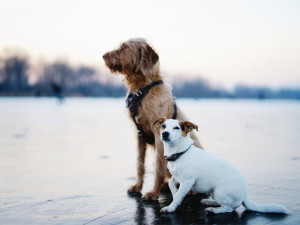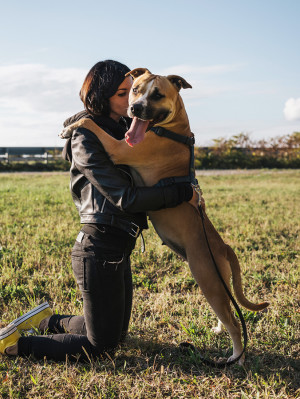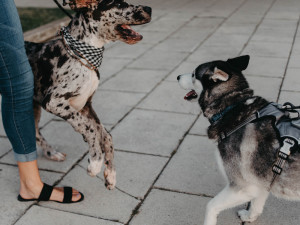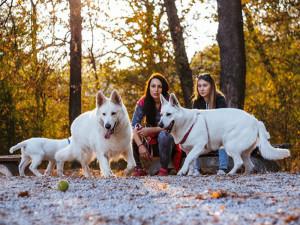How to Learn the Signs of Aggression In Dogs So You Can Get Them Some Doggy Therapy
Experts agree: breed doesn’t have anything to do with it.
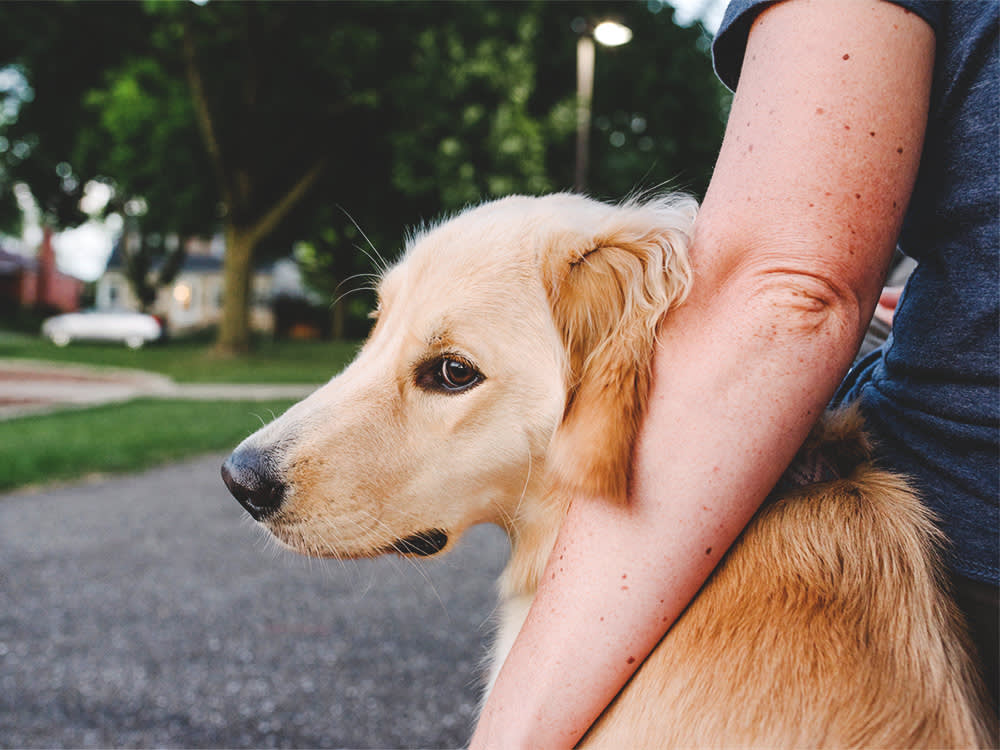
Share Article
Not a week goes by that I don’t get asked what kinds of dogs I think are the most dangerous. When people wonder about the “kinds” of dangerous dogsopens in a new tab, they typically think about breeds. But breed doesn’t have anything to do with it. People should focus on individual dogs and specific circumstances rather than a dog’s breed.
Dogs rarely, if ever, bite without warningsopens in a new tab, and sometimes those signs of trouble have been going on for months or even years before the bite happens. Here’s the thing: the problem isn’t unpredictable dogs. It’s misunderstood dogs. Dogs often try hard to communicate that they are uncomfortable or don’t like what is happening to them. But if nobody understands those messages, the dogs continue to be in situations that make them unhappy, and some of those dogs may end up biting.

Get (totally free) deals for food, treats, accessories, tech, and way more pet parenting must-haves.
opens in a new tabAs a professional behaviorist and trainer, I know we need to better educate people about the red flags of potential aggression in dogsopens in a new tab. Red flags exist but are not always picked up on. Here’s what you need to know about dangerous dogs.
Five most dangerous dogs
While not every dog in these categories is dangerous, it’s important to be aware that there is an increased risk of dog bites when dealing with these types of dogs or dogs in these situations.
1. Fearful dogs.
Dogs who are scaredopens in a new tab, nervous, or anxious opens in a new tabmay panic and act aggressively in order to protect themselves. And remember, a wagging tailopens in a new tab does not mean that a dog is friendly. Being afraid is at the root of more dog aggression than any other factor.
2. Untrained dogs.
If a dog has no boundaries opens in a new taband has never been taught how to behave, they are more likely to injure someone — perhaps by accident. People (especially children) are often bitten, scared, or hurt by dogs chasing them or jumping up on them.
3. Unpredictable dogs.
If a dog’s behavior is confusing and does not follow any obvious pattern, it’s easy to be taken off guard by their actions or inadvertently do something that upsets them. Don’t touch a dog who is sleepingopens in a new tab, eatingopens in a new tab, or chewing a toyopens in a new tab. Respect their space — startled dogs are more likely to bite.
4. Tired or sick dogs.
Just like people, dogs are not at their best when they don’t feel well and most would prefer not to be bothered. Dogs don’t have many ways to let us know that they’re in painopens in a new tab or that they want to be left aloneopens in a new tab. They sometimes resort to a growlopens in a new tab, snap, or bite, especially if they’ve already tried to walk away and go off by themselves, and that didn’t get the message across.
5. Unfamiliar dogs.
Not all dogs consider everyone a friend immediately. Many dogs need time to warm up to new people and don’t like being treated as a long-lost friend within five seconds of being introduced. Treating an unfamiliar dog like your best friend can be off-putting to some and lead to aggressive behavior. If you adore all dogs, remember that the feeling of love at first sight may not always be mutual.
Are certain dog breeds more dangerous?
Stereotyping breedsopens in a new tab to predict aggressive behavior is not useful or fair. The predictability of aggression based on a dog’s breed is highly overrated. The idea of breed bans or rejecting certain animals simply because their relatives have misbehaved is not going to get us anywhere.
Certain breeds are getting more bad press than they deserve, and aggression is a stereotype that seems to stick, even if other generalities are fitting. For example, most people with a Pit Bull know their pitty is more likely to lick an intruder to death than bite them. Yet, most of what we hear aboutopens in a new tab is Pit Bull aggression, not excessive licking. Rottweilers and Dobermans are also breeds that many people fear on sight without any actual data about the particular animal in question.
On the other hand, there’s no denying that certain lines of dogs that have been bred for aggression do exhibit it. Regrettably, aggression is easy to breed for if that is someone’s intent. However, not all members of breeds who have been bred for aggression are from lines with that sort of breeding history. Nurture is keyopens in a new tab, and anyone can make a fearful, aggressive dog with improper care.
In my experience, some dog breeds who more commonly have aggression issues are Golden Retrievers and Labrador Retrievers. Are these bad dogs? Aggressive breeds? Of course not. They are just common breedsopens in a new tab, so statistically are more likely to be noted as aggressive. Any breed can have an aggression issue. Aggression is far more predictable based on a dog’s previous behavior than on the breed.
Why do dogs bite?
It’s important when working with an aggressive dog to understand as much as possible about why the dog is biting. Some dogs bite because of fear, because they feel threatened, because they’re in pain, or they feel overwhelmed.
Dogs use their mouths both playfully and not so playfully as puppies, and the vast majority of them develop normal bite inhibitionopens in a new tab — an understanding of what they are and are not allowed to do with their mouths. Biting is a normal part of canine behavior. While people are more inclined to hit when behaving aggressively, emotions such as anger and frustration combined with high arousal are typically involved with dogs who bite in an out-of-control way.
Such bites happen when dogs have the canine equivalent of a toddler’s tantrum because they don’t get what they want. Dogs who bite in these contexts are literally unable to control themselves. It is much harder to substantially improve their behavior compared with other dogs, most of whom are biting as a result of fear.
Signs of aggression before the bite
Some dogs already have a bite history towards dogs or people and that’s a clear warning it could happen again — especially if it was an attack that was prolonged and hard to stop. Such relentless aggression is a serious red flag that the dog has trouble with inhibition.
Other typical warning signs that a dog may bite include growling, barking, lunging, tooth displaying especially with an offensive pucker, a tendency to get frustrated, difficulty calming down after getting revved up, going stiff, tongue flicking, charging at anything of interest, hard stares directed at another individual, facial expressions indicating nervousness or discomfort, becoming mouthy when in an aroused state, excessive sniffing of the ground in social situations, guarding food or toys and being fearful of people, animals, or any other object.
What to do if your dog has signs of aggression
Any of these signs, or even the general feeling that something is amiss, warrants a consultation with a person trained to deal with serious behavioral problems in dogs, such as a certified applied animal behaviorist, trainer, or veterinarian board certified in behavior. It’s better to get ahead of aggression with good trainingopens in a new tab.
It’s also helpful to get an outside perspective on how you interact with your dog and your home life, or other environments you spend a lot of time with your dog in. Often, aggression comes from stress or fear, and it may simply be a matter of de-stressing your pup’s life.
There’s hope for the overwhelming majority of dogs with a bite history, as many are able to improve their behavior with a combination of behavior modification and a sensible management plan for prevention. However, there is the rare dog whose likelihood of improvement is small because of a lack of any kind of self-control and the tendency to bite when frustrated, angry, and aroused.
Give your dog some grace, and some care, and these are hopefully issues that never go beyond a warning growl.

Karen B. London, PhD, CAAB, CPDT-KA
Karen B. London, Ph.D., is a Certified Applied Animal Behaviorist and Certified Professional Dog Trainer who specializes in working with dogs with serious behavioral issues, including aggression, and has also trained other animals including cats, birds, snakes, and insects. She writes the animal column for the Arizona Daily Sun and is an Adjunct Professor in the Department of Biological Sciences at Northern Arizona University. She is the author of six books about training and behavior, including her most recent, Treat Everyone Like a Dog: How a Dog Trainer’s World View Can Improve Your Lifeopens in a new tab.
Related articles
![Big and small dog standing together at a park]() opens in a new tab
opens in a new tabBig dogs, Small dogs: Does Size Affect Behavior?
How is the experience of having a large dog different than that of having a small dog?
![A woman embraces her American Staffordshire terrier dog outdoor in the backyard.]() opens in a new tab
opens in a new tab7 Myths Harmful to Pit Bulls—Debunked
These sweet pups need advocates, this National Pit Bull Awareness Month, and always.
![Great Dane puppy and Husky meeting on leash out side.]() opens in a new tab
opens in a new tabUnderstanding Reactivity and Aggression in Dogs: Two Very Different Things
Turns out, even experts have a hard time defining these terms.
![two woman at dog park talking while watching their dogs play]() opens in a new tab
opens in a new tab13 Common Dog Behavior Myths Overheard at Dog Parks
Many pet parents share information at the dog park, but is the information always accurate?
![Three dogs biting a stick.]() opens in a new tab
opens in a new tabSome Like It Rough: Playing Vs. Fighting
Two animal behavior experts agree it’s usually play fighting. Here’s how you can tell.




